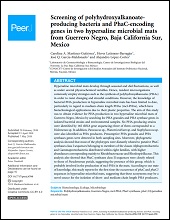Screening of polyhydroxyalkanoateproducing bacteria and PhaC-encoding genes in two hypersaline microbial mats from Guerrero Negro, Baja California Sur, Mexico
Autor
CAROLINA ALEJANDRA MARTINEZ GUTIERREZ
HEVER LATISNERE BARRAGAN
JOSE QUINATZIN GARCIA MALDONADO
ALEJANDRO LOPEZ CORTES
Metadatos
Mostrar el registro completo del ítemResumen
"Hypersaline microbial mats develop through seasonal and diel fluctuations, as well as under several physicochemical variables. Hence, resident microorganisms commonly employ strategies such as the synthesis of polyhydroxyalkanoates (PHAs) in order to resist changing and stressful conditions. However, the knowledge of bacterial PHA production in hypersaline microbial mats has been limited to date, particularly in regard to medium-chain length PHAs (mcl-PHAs), which have biotechnological applications due to their plastic properties. The aim of this study was to obtain evidence for PHA production in two hypersaline microbial mats of Guerrero Negro, Mexico by searching for PHA granules and PHA synthase genes in isolated bacterial strains and environmental samples. Six PHA-producing strains were identified by 16S rRNA gene sequencing; three of them corresponded to a Halomonas sp. In addition, Paracoccus sp., Planomicrobium sp. and Staphylococcus sp. were also identified as PHA producers. Presumptive PHA granules and PHA synthases genes were detected in both sampling sites. Moreover, phylogenetic analysis showed that most of the phylotypes were distantly related to putative PhaC synthases class I sequences belonging to members of the classes Alphaproteobacteria and Gammaproteobacteria distributed within eight families, with higher abundances corresponding mainly to Rhodobacteraceae and Rhodospirillaceae. This analysis also showed that PhaC synthases class II sequences were closely related to those of Pseudomonas putida, suggesting the presence of this group, which is probably involved in the production of mcl-PHA in the mats. According to our state of knowledge, this study reports for the first time the occurrence of phaC and phaC1 sequences in hypersaline microbial mats, suggesting that these ecosystems may be a novel source for the isolation of short- and medium-chain length PHA producers."
Colecciones
Ítems relacionados
Mostrando ítems relacionados por Título, autor o materia.
-
PROMOCIÓN DEL PERIFITON PARA EL CULTIVO DE CAMARÓN BLANCO: HACIA UNA ACUICULTURA ECOLÓGICA
DOMENICO VOLTOLINA LOBINA; JUAN MANUEL AUDELO NARANJO; MARIA DEL ROSARIO PACHECO MARGES -
Suelo y Erosión
YOLANDA LOURDES MAYA DELGADO


